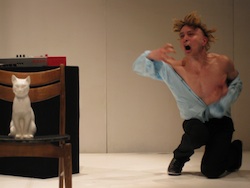It is easy to predict that when major Montréal dance artists come to celebrate their anniversaries in the profession, they will head to the cavernous Place des Arts. For most its an opportunity to fill major numbers of seats and top up the coffers. But it was a poor choice for Margie Gillis, whos marking her thirtieth season this year. She is the kind of artist who benefits from a more intimate venue.
Audiences probably watch Gillis work differently from the way they watch other kinds of dance. Many come in awe, ready to receive the work with reverence and devotion. At the recent anniversary concert, for example, one middle-aged man a few rows ahead of me looked like he was ready to fling himself on stage (he didnt), but he did rush to throw his “billet doux” at her feet. Gillis is, for some fans, the personification of beauty, and the dance world made accessible. Her actions on stage dont press on the mind and generally you get what she doing when shes doing it. Her reputation is one of making dances that are poignant and easy to watch. But what people often forget about Gillis, and perhaps what she scrupulously realized in her early performances through the 1980s, is that by capitalizing on her visceral performance energy she produces authentic results.
Now having turned fifty, her works also seemed to have turned a corner: shes veering in a new direction, in a departure from the youthful, heart-on-sleeve emotion of her earlier days. So perhaps its a question of transition: is it possible for Gillis work to reflect her maturity as a dancer, a choreographer, a woman, and perhaps the concerns of someone looking to the future and contemplating age rather than hearkening back to youth and more raw emotion? Or is that one of her perils?
Gillis made her name dancing in parks in China in 1979 she was the first to bring modern dance to the masses after the Revolution. With her bare feet, her enthusiasm, and her long mane of hair, she must have been a force to be reckoned with, Mao and the Gang of Four be damned. Over the years she has commanded an astonishing response the world over. As an essentially solo performer (her forays in collaboration have been rather limited in the past), she has sustained the mantle for three decades. There is something to be said for that, but also that she has delivered with great consistency. She has learned to work with her technical limitations, marshalled her dances, and made her dancing at once appear spontaneous and yet masterfully controlled.
Just take another look at her magnificent “Waltzing Matilda” (which she performed again at the anniversary concert, for the first time in years). Choreographed twenty-five years ago, Gillis chose the powerful Tom Waits rendition of the tune and, to his fervent rumblings and guttural fortissimos, created an arresting portrait of the crushing tones of youth. People have it all wrong when they comment that Gillis picks evocative music and plays off the audiences heartstrings. As is the case with “Matilda”, Gillis not only understands tempo, but she also finely tunes the dynamics of the movement, building on her imprimatur in terms of style of expression. To watch Gillis perform the piece again was to re-experience the raw feelings of youth (mine and hers). Dance rarely gets as deeply emotional.
Unfortunately, on this night, full of later career creations, only “Waltzing Matilda” and perhaps the piece, “Blue” — choreographed in 1998 and set to Leonard Cohens “Famous Blue Raincoat” — demonstrated this power. These earlier dances are achingly self aware, with the latter foreshadowing the more stationary nature of the dancing that followed on the program.
Irene Dowds “Viridian”, in its world premiere, was full of hesitation. Dressed in a puffy ill-conceived costume, Gillis spins in half circles. Her movement is punctuated with flourishes of the arms and hands, giving a sharpness to some of the angles. A slight limp in her gait made me wonder about a possible latent injury.
For another of Gillis own creations, “Elimination”, also a world premiere, she performs in a black body suit. She gesticulates from a standing position, displaying a kind of semaphore of movement. Reminiscent of old photos or portraiture come to life, the emphasis is once again on the upper body shifting position. “Breathing with Bird Bone”, another Gillis world premiere, dedicated to Linda Stearns, conveyed giddiness and girlishness, and comic misadventures.
The final offering on the program, “What the Wind Whispers”, was set to the glorious sounds of soprano Jessye Norman and pianist Daniel Barenboim. This piece also had the static quality of the previous work, but this time, in the august company of her musical partners and with a sashay of her hair, Gillis was able to flaunt notions of refinement and aesthetic elevation.
All told, it appears that to compensate for whatever is ailing her, or based on artistic choices or advice of some kind, Gillis is contouring her movement in a very specific direction, one in which she seems to rely on charisma more than a deeper sentience. Her physical power is much diminished in these new works but, as she is more than capable of dancing with passion in “Waltzing Matilda”, it seems that artistically, Gillis is lunging headlong into a career turn laced with inflated pronouncements of beauty. Gone is the urgent nature of her dancing, the exposed nerves, and the looseness she had in her earlier works. Her dance once burned with vulnerable, intelligent life, but not these new works. Gillis has the power to set peoples emotions free. But this time around, shes playing with montages of imagery and immortality, and ultimately distilling the almost unbearable sensitivity of what went before.
Tagged: Contemporary, Performance, Montréal , QC





